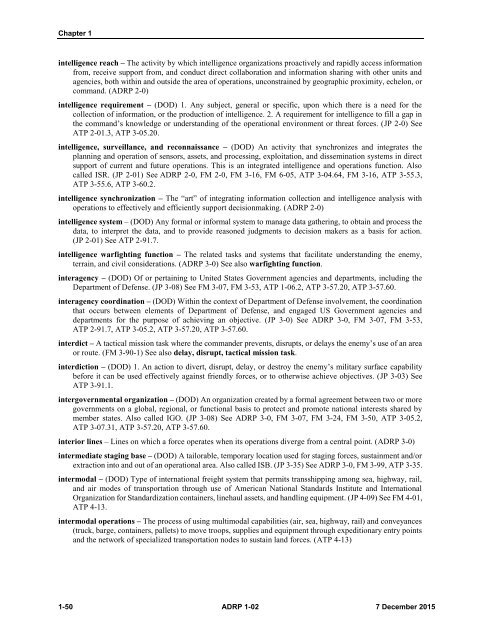ADRP1-02
52543f77c16bcfa46f6e1de2B038ef195
52543f77c16bcfa46f6e1de2B038ef195
Create successful ePaper yourself
Turn your PDF publications into a flip-book with our unique Google optimized e-Paper software.
Chapter 1<br />
intelligence reach – The activity by which intelligence organizations proactively and rapidly access information<br />
from, receive support from, and conduct direct collaboration and information sharing with other units and<br />
agencies, both within and outside the area of operations, unconstrained by geographic proximity, echelon, or<br />
command. (ADRP 2-0)<br />
intelligence requirement – (DOD) 1. Any subject, general or specific, upon which there is a need for the<br />
collection of information, or the production of intelligence. 2. A requirement for intelligence to fill a gap in<br />
the command’s knowledge or understanding of the operational environment or threat forces. (JP 2-0) See<br />
ATP 2-01.3, ATP 3-05.20.<br />
intelligence, surveillance, and reconnaissance – (DOD) An activity that synchronizes and integrates the<br />
planning and operation of sensors, assets, and processing, exploitation, and dissemination systems in direct<br />
support of current and future operations. This is an integrated intelligence and operations function. Also<br />
called ISR. (JP 2-01) See ADRP 2-0, FM 2-0, FM 3-16, FM 6-05, ATP 3-04.64, FM 3-16, ATP 3-55.3,<br />
ATP 3-55.6, ATP 3-60.2.<br />
intelligence synchronization – The “art” of integrating information collection and intelligence analysis with<br />
operations to effectively and efficiently support decisionmaking. (ADRP 2-0)<br />
intelligence system – (DOD) Any formal or informal system to manage data gathering, to obtain and process the<br />
data, to interpret the data, and to provide reasoned judgments to decision makers as a basis for action.<br />
(JP 2-01) See ATP 2-91.7.<br />
intelligence warfighting function – The related tasks and systems that facilitate understanding the enemy,<br />
terrain, and civil considerations. (ADRP 3-0) See also warfighting function.<br />
interagency – (DOD) Of or pertaining to United States Government agencies and departments, including the<br />
Department of Defense. (JP 3-08) See FM 3-07, FM 3-53, ATP 1-06.2, ATP 3-57.20, ATP 3-57.60.<br />
interagency coordination – (DOD) Within the context of Department of Defense involvement, the coordination<br />
that occurs between elements of Department of Defense, and engaged US Government agencies and<br />
departments for the purpose of achieving an objective. (JP 3-0) See ADRP 3-0, FM 3-07, FM 3-53,<br />
ATP 2-91.7, ATP 3-05.2, ATP 3-57.20, ATP 3-57.60.<br />
interdict – A tactical mission task where the commander prevents, disrupts, or delays the enemy’s use of an area<br />
or route. (FM 3-90-1) See also delay, disrupt, tactical mission task.<br />
interdiction – (DOD) 1. An action to divert, disrupt, delay, or destroy the enemy’s military surface capability<br />
before it can be used effectively against friendly forces, or to otherwise achieve objectives. (JP 3-03) See<br />
ATP 3-91.1.<br />
intergovernmental organization – (DOD) An organization created by a formal agreement between two or more<br />
governments on a global, regional, or functional basis to protect and promote national interests shared by<br />
member states. Also called IGO. (JP 3-08) See ADRP 3-0, FM 3-07, FM 3-24, FM 3-50, ATP 3-05.2,<br />
ATP 3-07.31, ATP 3-57.20, ATP 3-57.60.<br />
interior lines – Lines on which a force operates when its operations diverge from a central point. (ADRP 3-0)<br />
intermediate staging base – (DOD) A tailorable, temporary location used for staging forces, sustainment and/or<br />
extraction into and out of an operational area. Also called ISB. (JP 3-35) See ADRP 3-0, FM 3-99, ATP 3-35.<br />
intermodal – (DOD) Type of international freight system that permits transshipping among sea, highway, rail,<br />
and air modes of transportation through use of American National Standards Institute and International<br />
Organization for Standardization containers, linehaul assets, and handling equipment. (JP 4-09) See FM 4-01,<br />
ATP 4-13.<br />
intermodal operations – The process of using multimodal capabilities (air, sea, highway, rail) and conveyances<br />
(truck, barge, containers, pallets) to move troops, supplies and equipment through expeditionary entry points<br />
and the network of specialized transportation nodes to sustain land forces. (ATP 4-13)<br />
1-50 ADRP 1-<strong>02</strong> 7 December 2015


